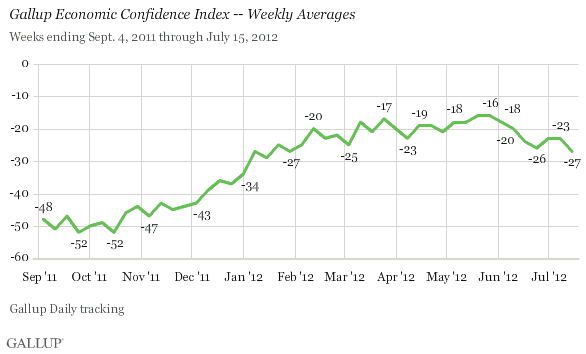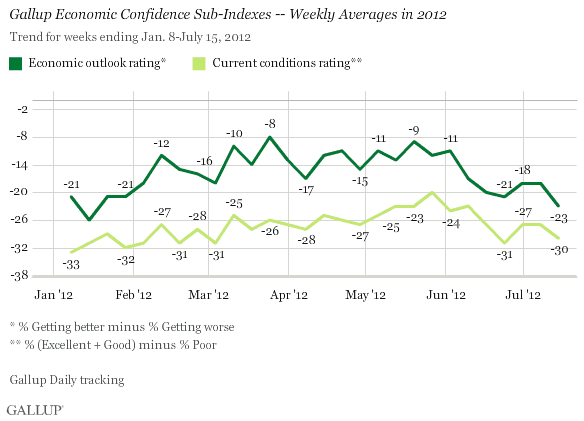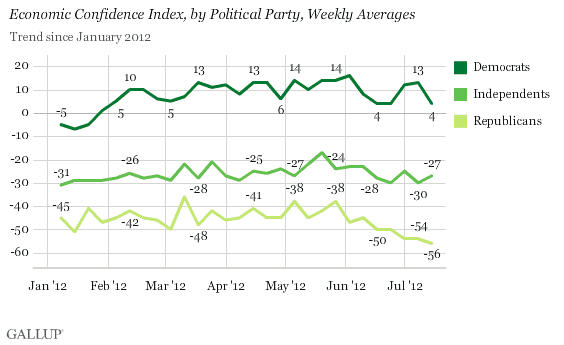PRINCETON, NJ -- Gallup's U.S. Economic Confidence Index averaged -27 for the week ending July 15, down four points from -23 each of the prior two weeks. This extends a gradual decline in confidence that has been underway since late May, when the index was at a four-year best of -16. The index was nearly this low a month ago -- at -26 in mid-June -- and now stands at the lowest weekly average since late January of this year.

The latest weekly average is based on 3,421 national adults interviewed as part of Gallup Daily tracking from July 9-15. This represents the first full week of interviewing after the government's July 6 jobs report was issued, showing weak job growth in June.
Both components of the index worsened in last week, with Americans' perceptions of the economy's direction falling most sharply -- to -23 from -18 -- the lowest for that component since January. Ratings of current economic conditions dipped to -30 from -27, similar to previous low readings as recently as June and March.

Last Week's Decline Driven by Democrats
Economic confidence fell nine points among Democrats (from +13 to +4), compared with a two-point drop among Republicans (-54 to -56), while independents' confidence rose slightly, from -30 to -27. Despite this, Democrats remain the most upbeat about the economy -- as is expected under a Democratic president -- while Republicans are substantially negative and independents fall roughly in between.
Part of the reason Republicans' confidence did not drop more last week may be that it has already tumbled quite steeply since May, from -38 to -54, at the same time that Democrats' -- and in particular independents' -- confidence was more stable. That GOP decline may reflect heightened politicization of Republicans' ratings of the economy as the November election nears, with Republicans increasingly viewing their ratings of the economy as commentary on President Barack Obama.

Bottom Line
Gallup's first full week of polling following the Bureau of Labor's lackluster unemployment report on July 6, found confidence again turning -- after having held on to improvements seen since mid-June.
One positive finding is that the immediate after effect of the report may already be fading. Gallup Daily tracking's three-day rolling averages showed a clear decline to -26 for July 6-8, compared with -19 in the three days prior, and a further decline to -29 by July 8-10. However, it has since rebounded to -23. While Americans' economic mood was relatively glum last week, it is unlikely to get worse this week and thus far, at least, seems to be mildly improving. Still, confidence remains quite negative, and below the level that Gallup has determined may be necessary for President Barack Obama to achieve re-election-friendly job approval ratings.
Gallup.com reports results from these indexes in daily, weekly, and monthly averages and in Gallup.com stories. Complete trend data are always available to view and export in the following charts:Daily: Employment, Economic Confidence, Job Creation, Consumer Spending
Weekly: Employment, Economic Confidence, Job Creation, Consumer Spending
Read more about Gallup's economic measures.
View our economic release schedule.
Survey Methods
Results are based on telephone interviews conducted as part of Gallup Daily tracking July 9-15, 2012, with a random sample of 3,421 adults, aged 18 and older, living in all 50 U.S. states and the District of Columbia.
For results based on the total sample of national adults, one can say with 95% confidence that the maximum margin of sampling error is ±4 percentage points.
Interviews are conducted with respondents on landline telephones and cellular phones, with interviews conducted in Spanish for respondents who are primarily Spanish-speaking. Each sample includes a minimum quota of 400 cell phone respondents and 600 landline respondents per 1,000 national adults, with additional minimum quotas among landline respondents by region. Landline telephone numbers are chosen at random among listed telephone numbers. Cell phones numbers are selected using random digit dial methods. Landline respondents are chosen at random within each household on the basis of which member had the most recent birthday.
Samples are weighted by gender, age, race, Hispanic ethnicity, education, region, adults in the household, and phone status (cell phone-only/landline only/both, cell phone mostly, and having an unlisted landline number). Demographic weighting targets are based on the March 2011 Current Population Survey figures for the aged 18 and older non-institutionalized population living in U.S. telephone households. All reported margins of sampling error include the computed design effects for weighting and sample design.
The questions reported here were asked of a random half-sample of respondents for seven nights on the Gallup Daily tracking survey.
In addition to sampling error, question wording and practical difficulties in conducting surveys can introduce error or bias into the findings of public opinion polls.
For more details on Gallup's polling methodology, visit https://www.gallup.com/.
